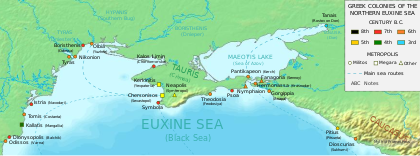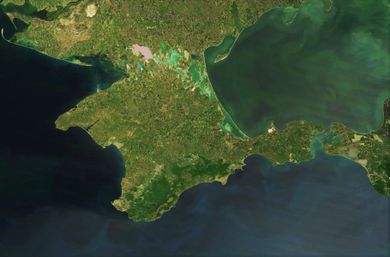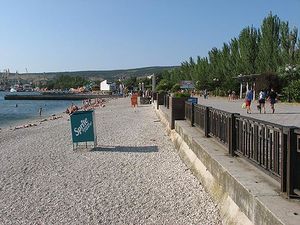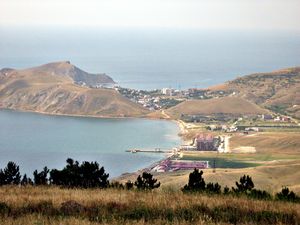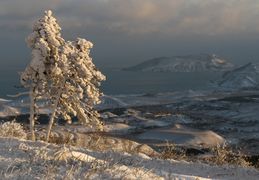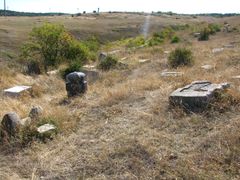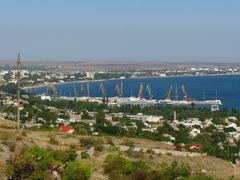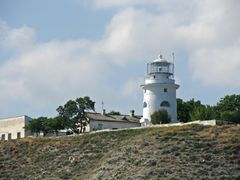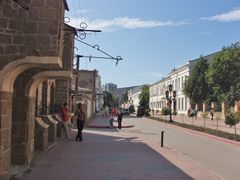فيودوسيا
Feodosia
Феодосия Феодосія Kefe | |
|---|---|
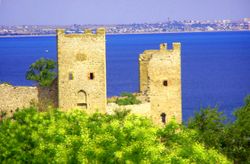 Genoese fortress of Caffa | |
| الإحداثيات: 45°2′56″N 35°22′45″E / 45.04889°N 35.37917°E | |
| Country | Disputed: |
| Republic | |
| Municipality | Feodosia Municipality |
| المنسوب | 50 m (160 ft) |
| التعداد (2015) | |
| • الإجمالي | 69٬145 |
| منطقة التوقيت | UTC+3 (MSK) |
| Postal code | 298100–298175 |
| مفتاح الهاتف | +7-36562 |
| Former names | Kefe (until 1784), Caffa (until the 15th century) |
| Climate | Cfa |
| الموقع الإلكتروني | feo |
فيودوسيا (روسية: Феодосия, Feodosiya؛ أوكرانية: Феодо́сія؛ Feodosiia؛[1] إنگليزية: Feodosia؛ تتارية القرم و بالتركية: كافه Kefe)، كما تُدعى ثيودوسيا Theodosia (من باليونانية: Θεοδοσία)، هي ميناء and resort, a town of regional significance in Crimea on the Black Sea coast. Feodosia serves as the administrative center of Feodosia Municipality, one of the regions into which Crimea is divided. During much of its history the city was known as Caffa (Ligurian: Cafà) or Kaffa. Population: 69,145 (تعداد 2014).[2]
التاريخ
ثودوسيا
The city was founded as Theodosia (Θεοδοσία) by Greek colonists from Miletos in the 6th century BC. Noted for its rich agricultural lands, on which its trade depended, it was destroyed by the Huns in the 4th century AD.
Theodosia remained a minor village for much of the next nine hundred years. It was at times part of the sphere of influence of the Khazars (excavations have revealed Khazar artifacts dating back to the 9th century) and of the Byzantine Empire.
Like the rest of Crimea, this place (village) fell under the domination of the Kipchaks and was conquered by the Mongols in the 1230s.
كافه
In the late 13th century, traders from the Republic of Genoa arrived and purchased the city from the ruling Golden Horde. They established a flourishing trading settlement called Kaffa, which virtually monopolized trade in the Black Sea region and served as a major port and administrative center for the Genoese settlements around the Sea. It came to house one of Europe's biggest slave markets. From 1266 and on, Kaffa was governed by a Genoese consul, who since 1316 was in charge of all Genoese Black Sea colonies. Between 1204–1261 and again in 1296–1307, the city of Kaffa was ruled by Republic of Genoa's chief rival, the Republic of Venice.[بحاجة لمصدر]
Ibn Battuta visited the city, noting it was a "great city along the sea coast inhabited by Christians, most of them Genoese." He further stated, "We went down to its port, where we saw a wonderful harbor with about two hundred vessels in it, both ships of war and trading vessels, small and large, for it is one of the world's celebrated ports."[3]
In early 1318 Pope John XXII established a Latin Church diocese of Kaffa, as a suffragan of Genoa. The papal bull of appointment of the first bishop attributed to him a vast territory: "a villa de Varna in Bulgaria usque Sarey inclusive in longitudinem et a mari Pontico usque ad terram Ruthenorum in latitudinem" ("from the city of Varna in Bulgaria to Sarey inclusive in longitude, and from the Black Sea to the land of the Ruthenians in latitude"). The first bishop was Fra' Gerolamo, who had already been consecrated seven years before as a missionary bishop ad partes Tartarorum. The diocese ended as a residential bishopric with the capture of the city by the Ottomans in 1475.[4][5][6] Accordingly, Kaffa is today listed by the Catholic Church as a titular see.[7]
It is believed that the devastating pandemic the Black Death entered Europe for the first time via Kaffa in 1347, through the movements of the Golden Horde. After a protracted siege during which the Mongol army under Janibeg was reportedly withering from the disease, they catapulted the infected corpses over the city walls, infecting the inhabitants, in one of the first cases of biological warfare. Fleeing inhabitants may have carried the disease back to Italy, causing its spread across Europe. However, the plague appears to have spread in a stepwise fashion, taking over a year to reach Europe from Crimea. Also, there were a number of Crimean ports under Mongol control, so it is unlikely that Kaffa was the only source of plague-infested ships heading to Europe. Additionally, there were overland caravan routes from the East that would have been carrying the disease into Europe as well.[8]
Kaffa eventually recovered. The thriving, culturally diverse city and its thronged slave market have been described by the Spanish traveler Pedro Tafur, who was there in the 1430s.[9] In 1462 Caffa placed itself under the protection of King Casimir IV of Poland.[10] However, Poland did not offer significant help due to reinforcements sent being massacred in Bar fortress (modern day Ukraine) by Duke Czartoryski after quarrel with locals.
كافه

Following the fall of Constantinople, Amasra, and lastly Trebizond, the position of Caffa had become untenable and attracted the attention of Ottoman Sultan Mehmed II. He was at no loss for a pretext to extinguish this last Genoese colony on the Black sea. In 1473, the tudun (or governor) of the Crimean Khanate died and a fight developed over the appointment of his successor. The Genoese involved themselves in the dispute, and the Tatar notables who favored the losing candidate finally asked Mehmed to settle the dispute. Mehmed dispatched a fleet under the Ottoman commander Gedik Ahmet Pasha, which left Constantinople 19 May 1475. It anchored before the walls of the city on 1 June, started the bombardment the next day, and on 6 June the inhabitants capitulated. Over the next few days the Ottomans proceeded to extract the wealth of the inhabitants, and abduct 1,500 youths for service in the Sultan's palace. On 8 July the final blow was struck when all inhabitants of Latin origin were ordered to relocate to Istanbul, where they founded a quarter (Kefeli Mahalle) which was named after the town they had been forced to leave.[11] Renamed Kefe, Caffa became one of the most important Turkish ports on the Black Sea.
In 1615 Zaporozhian Cossacks under the leadership of Petro Konashevych-Sahaidachny destroyed the Turkish fleet and captured Caffa. Having conquered the city, the cossacks released the men, women and children who were slaves.
فيودوسيا مرة أخرى
Ottoman control ceased when the expanding Russian Empire took over Crimea between 1774 and 1783. It was renamed Feodosiya (Ѳеодосія, reformed spelling: Феодосия), after the traditional Russian reading of the ancient Greek name. In 1900 Zibold constructed the first air well (dew condenser) on mount Tepe-Oba near Feodosiya.
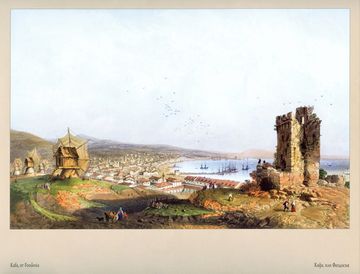
The city was occupied by the forces of Nazi Germany during World War II, sustaining significant damage in the process. The Jewish population numbering 3,248 before the German occupation was murdered by SD-Einsatzgruppe D between November 16 and December 15, 1941.[12] A witness interviewed by Yahad-In Unum described how the Jews were rounded-up in the city: "Posters announced that the Jews had to go to jail with food reserves for three days because they will be taken to Israel."[13] A monument commemorating the Holocaust victims is situated at the crossroads of Kerchensky and Symferopolsky highways. On Passover eve, April 7, 2012, unknown persons desecrated, for the sixth time, the monument, allegedly as an anti-Semitic act.[14] All native Tatar inhabitants were arrested by Russian forces as, according to Stalin, several thousand Tartars had fought side-by-side with the Nazis against Soviet forces and had participated in the Jewish genocide. No reliable source or proof exists of Stalin's allegations. Following Stalin orders, all Tartars were sent to Kazakhstan, Uzbekistan and other Central Asian republics of the USSR.
الجغرافيا
المناخ
The climate is warm and dry and could be described as humid subtropical, but not as Mediterranean, because there is no apparent drying trend in the summer.
| Climate data for فيودوسيا | |||||||||||||
|---|---|---|---|---|---|---|---|---|---|---|---|---|---|
| Month | Jan | Feb | Mar | Apr | May | Jun | Jul | Aug | Sep | Oct | Nov | Dec | Year |
| Record high °C (°F) | 19.1 (66.4) |
18.6 (65.5) |
27.1 (80.8) |
27.5 (81.5) |
31.9 (89.4) |
35.4 (95.7) |
37.9 (100.2) |
38.1 (100.6) |
33.3 (91.9) |
29.0 (84.2) |
26.9 (80.4) |
21.8 (71.2) |
38.1 (100.6) |
| Mean daily maximum °C (°F) | 4.7 (40.5) |
5.1 (41.2) |
8.5 (47.3) |
14.6 (58.3) |
20.6 (69.1) |
25.7 (78.3) |
29.1 (84.4) |
28.7 (83.7) |
23.2 (73.8) |
17.0 (62.6) |
10.8 (51.4) |
6.5 (43.7) |
16.2 (61.2) |
| Daily mean °C (°F) | 1.8 (35.2) |
1.7 (35.1) |
4.9 (40.8) |
10.6 (51.1) |
16.2 (61.2) |
21.1 (70.0) |
24.2 (75.6) |
23.8 (74.8) |
18.7 (65.7) |
13.1 (55.6) |
7.5 (45.5) |
3.7 (38.7) |
12.3 (54.1) |
| Mean daily minimum °C (°F) | −0.8 (30.6) |
−1.1 (30.0) |
2.0 (35.6) |
7.2 (45.0) |
12.3 (54.1) |
16.8 (62.2) |
19.8 (67.6) |
19.5 (67.1) |
14.6 (58.3) |
9.6 (49.3) |
4.7 (40.5) |
1.2 (34.2) |
8.8 (47.8) |
| Record low °C (°F) | −25.0 (−13.0) |
−25.1 (−13.2) |
−14.0 (6.8) |
−5.5 (22.1) |
1.1 (34.0) |
5.0 (41.0) |
9.1 (48.4) |
9.4 (48.9) |
1.4 (34.5) |
−11.2 (11.8) |
−14.9 (5.2) |
−18.6 (−1.5) |
−25.1 (−13.2) |
| Average precipitation mm (inches) | 36 (1.4) |
41 (1.6) |
42 (1.7) |
37 (1.5) |
36 (1.4) |
43 (1.7) |
31 (1.2) |
49 (1.9) |
45 (1.8) |
38 (1.5) |
50 (2.0) |
51 (2.0) |
499 (19.6) |
| Average rainy days | 12 | 8 | 10 | 11 | 9 | 7 | 7 | 6 | 9 | 8 | 12 | 12 | 111 |
| Average snowy days | 8 | 8 | 6 | 0.3 | 0.1 | 0 | 0 | 0 | 0 | 0.1 | 2 | 6 | 31 |
| Average relative humidity (%) | 82 | 80 | 79 | 75 | 71 | 69 | 64 | 64 | 70 | 77 | 81 | 83 | 75 |
| Mean monthly sunshine hours | 63 | 72 | 129 | 182 | 252 | 283 | 308 | 287 | 246 | 166 | 85 | 51 | 2٬124 |
| Source 1: Pogoda.ru.net.[15] | |||||||||||||
| Source 2: NOAA (sun, 1961−1990)[16] | |||||||||||||
فيودوسيا المعاصرة
Modern Feodosiya is a resort city with a population of about 85,000 people.[بحاجة لمصدر] It has beaches, mineral springs, and mud baths, sanatoria, and rest homes. Apart from tourism, its economy rests on agriculture and fisheries, local industries include fishing, brewing and canning. As with much of the Crimea, most of its population is ethnically Russian; the Ukrainian language is infrequently used. In June 2006, Feodosiya made the news with the 2006 anti-NATO port riot.
While most beaches in Crimea are made of pebbles, there is a unique Golden Beach (Zolotoy Plyazh) made of small seashells in Feodosiya area. Golden Beach stretches for 15 km.
The city is sparsely populated during the winter months. Most cafes and restaurants are closed. Business and tourism increase in mid-June and peak during July and August. Like in the other resort towns in Crimea, the tourists come mostly from the C.I.S. countries of the former Soviet Union. Feodosiya was the city where the seascape painter Ivan Aivazovsky lived and worked all his life, and where general Pyotr Kotlyarevsky and the writer Alexander Grin spent their declining years. Popular tourist locations include the Aivazovsky National Art Gallery and the Genoese fortress.
الضم الروسي 2014
Crimea was annexed by Russia in early 2014 and the peninsula, Ukrainian territory since 1991, is now administered as two Russian federal subjects - the Republic of Crimea and the federal city of Sevastopol. The international community has overwhelmingly condemned the Russian Federation's acts in the Autonomous Republic of Crimea and the city of Sevastopol. United Nations General Assembly Resolutions 68/262 of 27 March 2014 [1], 71/205 of 19 December 2016 [2] and 72/190 of 19 December 2017 [3] confirmed the status of the Autonomous Republic of Crimea and the city of Sevastopol as part of the territory of Ukraine, condemned the occupation of Crimea by the Russian Federation and reaffirmed the non-recognition of the annexation of Crimea by the Russian Federation. The United Nations also called upon all States, international organizations and specialized agencies not to recognize any alteration of the status of the Autonomous Republic of Crimea and the city of Sevastopol and to refrain from any action or dealing that might be interpreted as recognizing any such altered status.
الاقتصاد والصناعة
- More PO (Primorsk)
- Sudokompozit - ship design R&D naval hardware
- Kasatka TsNII Gp NPO Uran (Gagra Pitsunda) - ship design R&D naval hardware
- Gidropribor FeOMMZ, torpedo manufacturing and ship yard (Ordzhonikidze)
- NPO Uran TsNII Gp "Kasatka" (Lab N°5 NII400) torpedoes (Gagra Pitsunda)
- Russia Black Sea Fleet Navy Ship repair Yards
- FOMZ Opto Mechanical Plant FKOZ
- Feodosia Economic Industrial Zone FPZ (west)
- Feodosia FMZ Engineering/Machine-building Plant
- Feodosia FPZ (Priborostroeni Priladobudivni) Instrument-making Plant
بلدات توأم—مدن شقيقة
أشخاص من فيودوسيا
- Ivan Aivazovsky, Armenian painter
- Roman Kapitonenko, Ukrainian boxer
- Andrzej Liczik, Ukrainian-Polish boxer
في الثقافة الشعبية
The late-medieval city of Caffa is the locale in a section of the novel Caprice and Rondo by Dorothy Dunnett.
An early 14th-century bishop of Caffa appears in Umberto Eco's novel The Name of the Rose, making several sharp replies in a long, tempestuous debate within a group of monks and clerics; he is portrayed as aggressive and somewhat narrow-minded.
انظر أيضاً
Ancient Karaites cemetery
الهامش
- ^ Про впорядкування транслітерації українського алфавіту... | від 27.01.2010 № 55
- ^ قالب:Crimea-pop-ref
- ^ Battutah, Ibn (2002). The Travels of Ibn Battutah. London: Picador. pp. 120–121. ISBN 9780330418799.
- ^ Pius Bonifacius Gams, Series episcoporum Ecclesiae Catholicae, Leipzig 1931, p. 432
- ^ Konrad Eubel, Hierarchia Catholica Medii Aevi, vol. 1, pp. 154–155; vol. 2, pp. XVIII e 117; vol. 3, p. 145; vol. 5, p. 134
- ^ Gasparo Luigi Oderico, Lettere ligustiche ossia Osservazioni critiche sullo stato geografico della Liguria fino ai Tempi di Ottone il Grande, con le Memorie storiche di Caffa ed altri luoghi della Crimea posseduti un tempo da' Genovesi, Bassano 1792 (especially p. 166 ff.)
- ^ Annuario Pontificio 2013 (Libreria Editrice Vaticana 2013 ISBN 978-88-209-9070-1), p. 855
- ^ Wheelis, Mark (September 2002). "Biological Warfare at the 1346 Siege of Kaffa". Emerging Infectious Diseases. 8 (9): 971–75. doi:10.3201/eid0809.010536. PMC 2732530. PMID 12194776.
- ^ Tafur, Andanças e viajes
- ^ D. Kołodziejczyk, The Crimean Khanate and Poland-Lithuania. International Diplomacy on the European Periphery (15th–18th Century) A Study of Peace Treaties Followed by Annotated Documents, Leiden - Boston 2011, p. 62, ISSN 1380-6076; ISBN 978 90 04 19190 7
- ^ Franz Babinger, Mehmed the Conqueror and his Time (Princeton: University Press, 1978), pp. 343ff.
- ^ Martin Gilbert, The Routledge Atlas of the Holocaust, 2002, pp.64, 83
- ^ "Yahad-In Unum Interactive Map". Execution Sites of Jewish Victims Investigated by Yahad-In Unum. Retrieved 10 February 2015.
- ^ "ФЕОДОСИЯ. Осквернен памятник жертвам Холокоста". Всеукраинский Еврейский Конгресс. Retrieved 24 August 2012.
- ^ "Weather and Climate-The Climate of Feodosia" (in Russian). Weather and Climate. Retrieved 1 March 2015.
{{cite web}}: CS1 maint: unrecognized language (link) - ^ "Feodosija Climate Normals 1961–1990". National Oceanic and Atmospheric Administration. Retrieved 1 March 2015.
للاستزادة
- Annette M. B. Meakin (1906). "Theodosia". Russia, Travels and Studies. London: Hurst and Blackett. OCLC 3664651.
{{cite book}}: External link in|chapterurl=|chapterurl=ignored (|chapter-url=suggested) (help)  Chisholm, Hugh, ed. (1911). . دائرة المعارف البريطانية. Vol. 26 (eleventh ed.). Cambridge University Press.
Chisholm, Hugh, ed. (1911). . دائرة المعارف البريطانية. Vol. 26 (eleventh ed.). Cambridge University Press. {{cite encyclopedia}}: Cite has empty unknown parameter:|coauthors=(help)- Гавриленко О. А., Сівальньов О. М., Цибулькін В. В. Генуезька спадщина на теренах України; етнодержавознавчий вимір. — Харків: Точка, 2017.— 260 с. — ISBN 978-617-669-209-6
وصلات خارجية
- WorldStatesmen- Ukraine
- Ancient Theodosia and its Coinage
- Tourist Theodosius
- The murder of the Jews of Feodosia during World War II, at Yad Vashem website.
خطأ لوا في وحدة:Authority_control على السطر 278: attempt to call field '_showMessage' (a nil value).
- Pages using gadget WikiMiniAtlas
- Short description is different from Wikidata
- Articles with hatnote templates targeting a nonexistent page
- Missing redirects
- Coordinates on Wikidata
- Articles containing روسية-language text
- Pages using Lang-xx templates
- Articles containing أوكرانية-language text
- Articles containing إنگليزية-language text
- Articles containing Greek-language text
- Articles with unsourced statements from December 2012
- Pages with empty portal template
- CS1 errors: unsupported parameter
- مقالات المعرفة المحتوية على معلومات من دائرة المعارف البريطانية طبعة 1911
- Milesian Pontic colonies
- اليونان الپنطية
- Feodosia Municipality
- المملكة البسفورية
- Cities in Crimea
- Taurida Governorate
- Former populated places in Eastern Europe
- Greek colonies in Crimea
- Khazar towns
- Milesian colonies in Crimea
- Populated places established in the 6th century BC
- منتجعات بحرية في روسيا
- Seaside resorts in Ukraine
- أقاليم جمهورية جنوة
- أقاليم جمهورية البندقية
- Port cities and towns in Russia
- Port cities and towns in Ukraine
- موانئ البحر الأسود
- مدن ذات حيثية إقليمية في أوكرانيا
- مدن ذات مجد عسكري
- مواقع المحرقة في أوكرانيا



